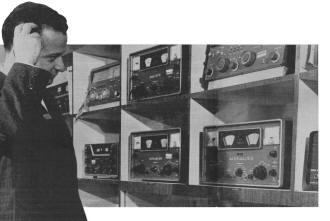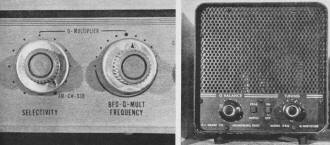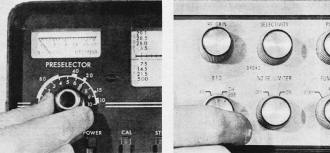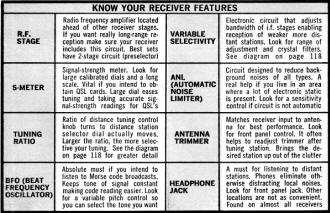| February 1965 Popular Mechanics |
 [Table of Contents] [Table of Contents]
Wax nostalgic about and learn from the history of early
mechanics and electronics. See articles from
Popular Mechanics,
published continuously since 1902. All copyrights hereby acknowledged.
|
In 1965 when this "Buyer's Guide to Shortwave Receivers"
article appeared in Popular Mechanics magazine, radio was a big deal.
Transmitting required a license of some sort, but anyone could buy a receiver
and listen. It was decades before the Internet and cellphones (which are radios)
would make anytime, anywhere communications possible. News services still
reported breaking stories via "wire" or "wireless." Only big media organizations
and local newspaper offices had access to worldwide happenings. Many people used
shortwave radio broadcasts to listen in on news from across the state, country,
and world. Of course a lot of it was in a foreign language, but many countries
also broadcast in English. Three-letter government agencies also listened in to
receive reports from inside Communist countries where some oppressed citizens
managed to operate bootleg transmitters. Listening for coded messages from
secret agents was good sport; there were groups who traded information on them -
much to the consternation of the government. Believe it or not, there is still
today a cadre of shortwave listeners who maintain websites for assisting and
trading info with the brethren. To wit: SWLing,
ShortwaveDB,
DXing
Buyer's Guide to Shortwave Receivers
 Amateur or all-wave? $39 or $150? And how
much of that alphabet soup of extras do you need? Try these shopping tips. Amateur or all-wave? $39 or $150? And how
much of that alphabet soup of extras do you need? Try these shopping tips.
By Larry Steckler
To tap that world of airwave adventure surrounding you - police calls, marine
communications, satellite signals, radio amateurs, aircraft or foreign broadcast
stations - you may think that you need only to switch on any shortwave radio receiver.
But step into a radio showroom, or leaf through the radio receiver pages of an
electronics catalog, and you enter a world of confusion.
Suddenly, you're surrounded by amateur and "all-wave receivers" ranging from
$39.95 to over $500 in price - not to mention a veritable alphabet soup of mysterious
abbreviations (BFO, ANL, AVC, Q multipliers, to name a few) which may or may not
be important to the type of shortwave listening you have in mind. We'll try and
sort out the significance of these alphabet extras for you in this article.
Before you walk into the showroom you should decide what type of listening you
intend to do - amateur radio or general-purpose "all-wave" shortwave listening.
The amateur receiver concentrates on the amateur radio bands at 3.5-, 7-, 14-, 21-
and 28-megacycles. The bandspread dial on these sets is calibrated for these bands.
What the Shortwave Dollar Will Buy
PRICE: Under $75
FEATURES
4 bands
No r.f. stage
540-kc to 30-mc
May not have S-meter
Fixed
frequency BFO
May not have headphone jack
PRICE: Under $100
4 bands
May not have r.f. stage
540-kc to 34-mc
S-meter, but may
not be calibrated
Fixed frequency BFO
Headphone jack
May have basic Q
multiplier
May have basic noise limiter
PRICE: Under $150
4 bands R.F. stage
540-kc to 34-mc
25:1 tuning ratio
S-meter
Automatic noise limiter
BFO, may be fixed frequency circuit Antenna trimmer
Headphone jack
PRICE: Under $200
5 bands
R.F. stage 540-kc to 34-mc
30:1 tuning ratio
Calibrated S-meter
BFO with pitch control
Automatic noise limiter
Basic Q multiplier
Dual conversion
Antenna trimmer
Headphone jack
PRICE: Under $300
5 bands
R.F. stage 540-kc to 34-mc
60:1 tuning ratio
Calibrated S-meter
Variable i.f. selectivity
Noise limiter automatic Automatic volume control
Single-sideband reception
Dual conversion
Antenna trimmer
Headphone
jack
PRICE: Under $450
6 bands
2 r.f. stages
540-kc to 109-mc
AM and FM (27-MC to 109-MC)
60:1 tuning ratio
Single sideband reception
Automatic volume control
Automatic noise limiter, adjustable
Triple conversion
Adjustable i.f.
selectivity, notch filter
Plug-in crystal tuning
Push-pull 10-watt audio
output
Clock timer
Antenna trimmer
Headphone jack

S-Meters measure signal strength. Standard types (top) are easiest
to read and large scale makes them most accurate. Current trend is to smaller vertical
dial. Avoid the uncalibrated ones. (center)
The general-purpose set, on the other hand, carries labels at around 1.6-mc.
(1600 kc) for police radio, 2.5-mc. for ship-to-shore phones, as well as amateur
frequencies and the most commonly used foreign-broadcast frequencies.
It is interesting to note that the 1.5 to 4-mc. area is generally good for reception
up to 300 miles and nighttime listening. From 4 to 8-mc., expect 300 miles daytime
and up to 1500 miles at night. From 8 to 14-mc., look for under 2000-mile range
during the day and over 2000 miles at night. For 14-mc. to 34-mc., expect 1500 miles
or more with best results in the early morning or evening.
Q-Multipliers narrow bandpass of the i.f. amplifiers resulting
in greater selectivity in the receiver. Means more stations and less jumble to you
Quarter Turn of high-ratio dial at left covers less tuning distance
(colored band) than same turn of low-ratio dial at right. Simplifies tuning.
Portable all-wave sets are usually transistorized and come with a built-in pole-type
antenna. In general, they will not perform as well as a nonportable receiver selling
for the same price. The built-in antenna can only deliver a small fraction (as little
as one tenth or less) the signal picked up by a long 150-foot single-wire antenna.
Also the portable's transistor circuitry is inherently noisier. When you are listening
to a strong station, this noise cannot even be heard. However, tune in a weak distant
signal and you may find yourself getting more noise than signal. For best performance
for the price, then, stick to a nonportable vacuum-tube type receiver.
Speaking of price, a key difference between rock-bottom $39 sets and more expensive
ones is that cheaper sets usually have fewer tubes.
When comparing receiver performance in the store and trying some of the tests
mentioned in this article, ask the salesman to be sure that the sets you try are
all connected to the same antenna. Most stores have a setup for switching any radio
on display to a particular antenna. But if you really want to play it safe, don't
rely on the switching. Try one set plugged into one particular antenna jack, then
unplug it and hook up the next one. A good set hooked to a poor antenna will not
perform as well as a poor set connected to a good antenna.
Three main factors determine quality.
They are stability, sensitivity and selectivity.
Stability refers to the set's ability to stay tuned to a station
and not drift off frequency. Check by tuning in a weak station for 10 minutes or
so. The station may fade in and out (volume level may change) but you should not
have to touch the tuning control again.
Sensitivity is the ability of a radio to receive a weak station.
Check by tuning in the same weak distant station on several sets. If one delivers
a stronger, clearer signal than the rest, it's the most sensitive set.
Selectivity is the receiver's ability to pick out one station
from a group of stations crammed tightly together. Tune a receiver to a crowded
portion of any band. Then, using the bandspread control, see how many stations you
can sort out of the jumble. Test several sets this way. The one that most easily
tunes in the largest number of stations is best.
The Alphabet Soup
Almost all short-wave radios include a headphone jack and an S-meter. The jack
should be mounted on the front panel for easy access. Headphones are a must for
good listening to weak or distant stations, and adding a jack to a set that doesn't
have one can sometimes be difficult.
If you start collecting QSLs (confirmation cards from the stations you listen
to), you want the S-meter to give you a signal-strength reading to relay to the
station when asking for a card. But the S-meter should be calibrated and have a
large easily read dial. If you have a real basic set that does not include an S-meter,
there's an accessory meter you can add.

Until Recently Q-multiplier circuits were only
available as accessories (right). Now they are being incorporated into design of
newer sets (left). They help separate shortwave stations that are crowded together
and overlapping.

Preselector (left)can really bring in long-range
broadcasts. This extra tuned r.f. stage is found in only the very best and most
costly shortwave receivers.
Cluster of Controls (right)looks impressive;
and noise-limiter knobs are switches, do not adjust. Rf. gain and selectivity controls
are not calibrated.

Slide Switches always look neat but frequently
lead to trouble. They are more likely to break down and require replacement or service
than standard toggle switches.
Noise Limiters are electronic circuits intended to protect your
ears against sudden loud bursts of static. Almost all receivers above the economy
class include such a circuit. Automatic noise limiters (ANL) are handy, but should
have a sensitivity control so you can select the point at which they go into operation;
an On-Off switch is not enough.
To compare such circuits, tune to a noisy spot on the dial, then flip in the
circuit and judge how effectively the noise level is cut back, without eliminating
the station signal you are trying to receive.
Know Your Receiver Features
R.F. Stage
Radio frequency amplifier located ahead of other receiver stages. If you want
really long-range reception make sure your receiver includes this circuit. Best
sets have 2·stage circuit (preselector)
S-Meter
Signal-strength meter. Look for large calibrated dials and a long scale. Vital
if you intend to obtain QSL cards. Large dial eases tuning and taking accurate signal-strength
readings for QSL's
Tuning Ratio
Ratio of distance tuning control knob turns to distance station selector dial
actually moves. Larger the ratio, the more selective your tuning. See the diagram
on page 118 for greater detail
BFO (Beat Frequency Oscillator)
Absolute must if you intend to listen to Morse code broadcasts. Keeps tone of
signal constant making code reading easier. Look for a variable pitch control so
you can select the tone you want
Variable Selectivity
Electronic circuit that adjusts bandwidth of i.f. stages enabling reception of
weaker more distant stations. Look for range of adjustment and crystal filters.
See diagram on page 118
ANL (Automatic Noise Limiter)
Circuit designed to reduce background noises of all types. A real help if you
live in an area where a lot of electronic static is present. Look for a sensitivity
control if circuit is not automatic
Antenna Trimmer
Matches receiver input to antenna for best performance. Look for front panel
control. It often helps to readjust trimmer after tuning station. Brings the desired
station up out of the clutter
Headphone Jack
A must for listening to distant stations. Phones eliminate otherwise distracting
local noises. Look for front panel jack. Other locations are not as convenient.
Found on almost all receivers
Beat-frequency oscillator (BFO)
Most shortwave radios have this oscillator which is triggered by code signals
you may want to tune in. The BFO keeps the pitch of code signals you receive constant.
But receivers that have a BFO should include a variable pitch control so you can
select both the most pleasing tone and one which can be most readily distinguished
from background noise.
 Preselector Preselector
Only better receivers include this extra tunable r.f. amplifier in front of the
other receiver circuits. It helps bring in weak, hard-to-hear stations. To check
its effectiveness, tune to a weak station on a set without a preselector and compare
reception of the same station on a set with a preselector.
Variable selectivity of the i.f. (intermediate frequency) circuits
is quite popular. One version of this circuit, called a Q-multiplier, lets you narrow
the range of frequencies your receiver is amplifying. This helps separate crowded
stations. Test by tuning to a crowded portion of some shortwave band, and seeing
how many different stations you can get both using the Q-multiplier and with it
off. Some Q-multipliers are more effective than others.
On some of the most expensive sets variable selectivity circuits include crystal
filters to give really sharp narrow bandwidth.
Calibrator (CAL).
On some receivers this circuit is built-in. It produces audible tones at precise
frequencies, so you can zero the set's dial tuning indicator to conform exactly
to the specific frequency it indicates. Make sure the dial itself can be easily
adjusted. If you want even more tuning precision, your set should have a crystal
type calibration circuit, which cannot drift off frequency. The crystal calibrator
is also available as an accessory you can add later.
Band spread.
The ratio of how far you have to turn the tuning knob to how far the dial moves
determines how finely you can tune to a station. Generally speaking, the more expensive
the set, the higher the tuning ratio. But make sure the tuning control moves smoothly
and easily.
How many bands?
Most all-wave sets cover all frequencies between 55G-kc. and about 34-mc. (Some
special sets cover other frequencies.) But within the normal frequency limits, a
set divides its range into a number of bands, usually four, five, or six. The more
bands there are. the finer the tuning and the easier it will be to select stations.
Posted December 11, 2023
|















